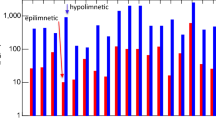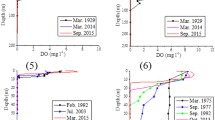Abstract
The thermal stratification of the lakes impedes the transfer of atmospheric oxygen into the lower layers of the lake. In lakes which are affected by diverse anthropogenic influences, the increasing organic matter amounts lead to a sharp decrease in hypolimnetic oxygen amounts, aided by thermal stratification, and anaerobic conditions arise. The determination of hypolimnetic oxygen demand (HOD) and areal hypolimnetic oxygen demand (AHOD) and their monitoring represent an integrated approach to investigate the oxygenation of lakes, the nutrient conditions, and the physicochemical dynamics. In this study, two lakes differing by size and affected by different anthropogenic sources, are investigated in this respect. At first, bathymetric studies were conducted to determine the depth, surface area, and volume relationships. Then, based on monitoring studies conducted in 2013 and 2014, the thermal stratification dynamics and layer properties were established using the relative thermal resistance to mixing (RTRM) index based on temperature and density profiles. Following this, the oxygen depletion rates were determined by oxygen and temperature profiling in the hypolimnion. For the years of 2013 and 2014, the AHOD values for the Borabey Pond which is far from anthropogenic influences, were found to be 0.848 and 0.569 g O2/(m·d), respectively. The AHOD values for the Porsuk Reservoir which was overburdened for years by industrial and domestic pollution were found to be 4.263 and 5.099 g O2/(m·d), larger than its counterpart by almost sevenfold. The HOD and AHOD monitoring can be considered to a valuable tool for assessing the ecological and chemical status of lakes within Annex 5 of the Water Framework Directive and as an integrated approach to assess and monitor the status of lakes.
Similar content being viewed by others
References
Albek E. 2003. Estimation of point and diffuse contaminant loads to streams by non-parametric regression analysis of monitoring data. Water, Air, and Soil Pollution, 147 (1-4): 229–243.
Alpaslan K, Sesli A, Tepe R, Özbey N, Birici N, Seker T, Kocer M A T. 2012. Vertical and seasonal changes of water quality in keban dam reservoir. Journal of FisheriesSciences.com, 6 (3): 252–262.
Anonymous. 2011. Short history of the Borabey Lake. www. sehirgazetesi.net, 2014.
Baharim N H, Ismail R, Omar M H. 2011. Effects of thermal stratification on the concentration of iron and manganese in a tropical water supply reservoir. Sains Malays iana, 40 (8): 821–825.
Becker V, Huszar V L M, Crossetti L O. 2009. Responses of phytoplankton functional groups to the mixing regime in a deep subtropical reservoir. Hydrobiologia, 628 (1): 137–151.
Bengtsson L, Herschy R W, Fairbridge R W. 2012. Encyclopedia of Lakes and Reservoirs. Springer, Netherlands.
Beutel M W. 2003. Hypolimnetic anoxia and sediment oxygen demand in California drinking water reservoirs. Lake and Reserv oir Manage ment, 19 (3): 208–221.
Birge E. 1910. An unregarded factor in lakes temperatures. Trans. Wis. Acad. Sci. Arts Lett., 16: 989–1004.
Borowiak D, Nowinski K, Baranczuk J, Marszelewski W, Skowron R, Solarczyk A. 2011. Relationship between areal hypolimnetic oxygen depletion rate and the trophic state of five lakes in northern Poland. Limnological Review, 11 (4): 135–142.
Branco C W C, Kozlowsky-Suzuki B, Sousa-Filho I F, Guarino A W S, Rocha R J. 2009. Impact of climate on the vertical water column structure of Lajes Reservoir (Brazil): a tropical reservoir case. Lakes & Reservoirs: Research & Management, 14 (3): 175–191.
Bryant L D, Gantzer P A, Little J C. 2011. Increased sediment oxygen uptake caused by oxygenation-induced hypolimnetic mixing. Water Research, 45 (12): 3692–3703.
Çevlik H, Elibol M I. 2009. Limnology of Yamula Dam. DSI Operation and Maintenance Department, Ankara, Turkey.
Chaplot V, Saleh A, Jaynes D B. 2005. Effect of the accuracy of spatial rainfall information on the modeling of water, sediment, and NO3-N loads at the watershed level. J ournal of Hydrol ogy, 312 (1-4): 223–234.
Chapra S C. 1997. Surface Water-Quality Modeling. McGraw-Hill Companies, Singapore.
Chimney M J, Wenkert L, Pietro K C. 2006. Patterns of vertical stratification in a subtropical constructed wetland in south Florida (USA). Ecol ogical Eng ineering, 27 (4): 322–330.
Collingsworth P D, Bunnell D B, Murray M W, Kao Y C, Feiner Z S, Claramunt R M, Lofgren B M, Höök T O, Ludsin S A. 2017. Climate change as a long-term stressor for the fisheries of the Laurentian Great Lakes of North America. Rev iews in Fish Biol ogy and Fish eries, 27 (2): 363–391.
Debroux J F, Beutel M W, Thompson C M, Mulligan S. 2012. Design and testing of a novel hypolimnetic oxygenation system to improve water quality in Lake Bard, California. Lake and Reserv oir Manage ment, 28 (3): 245–254.
Edlund M B, Almendinger J E, Fang X, Hobbs J M R, VanderMeulen D D, Key R L, Engstrom D R. 2017. Effects of climate change on lake thermal structure and biotic response in northern wilderness lakes. Water, 9 (9): 678.
Elci S. 2008. Effects of thermal stratification and mixing on reservoir water quality. Limnology, 9 (2): 135–142.
Ficker H, Luger M, Gassner H. 2017. From dimictic to monomictic: Empirical evidence of thermal regime transitions in three deep alpine lakes in Austria induced by climate change. Freshwater Biol ogy, 62 (8): 1335–1345.
Göncü S, Avdan U, Yigit Avdan Z, Albek E. 2014a. Monitoring the porsuk reservoir dissolved oxygen concentration based on stratification and investigation of a suitable hypolimnetic aeration method intended to increase the lake assimilation capacity. (1208F129).
Göncü S, Avdan U, Yigit Avdan Z, Hasanoglu E. 2014b. Obtaining of the bathymetry map by using acoustic Doppler device. In: Proceedings of the 7th National Engineering Measurements Symposium.
Green W R. 1996. Eutrophication trends inferred from hypolimnetic dissolved-oxygen dynamics within selected White River reservoirs, northern Arkansas-southern Missouri, 1974–94. U.S. Geological Survey.
Hutchinson G E. 1938. On the relation between the oxygen deficit and the productivity and typology of lakes. Internationale Revue der gesamten Hydrobiologie und Hydrographie, 36(2): 336–355.
Hutchinson G E. 1957. A Treatise on Limnology: Geography, Physics, and Chemistry. pt. 1. Geography and Physics of Lakes. Wiley.
Kaya M. 2013. Interaction of Water Quality with Basin Components in Small Water Bodies. Anadolu University, p.109.
Kortmann R W. 2011. RTRM Relative Thermal Resistance to Mixing. Ecosystem Consulting Service, Inc.
Lasenby D C. 1975. Development of oxygen deficits in 14 southern Ontario lakes1. Limnol ogy and Oceanogr aphy, 20 (6): 993–999.
Magee M R, Wu C H. 2017. Response of water temperatures and stratification to changing climate in three lakes with different morphometry. Hydrol ogy and Earth Syst em Sc iences, 21 (12): 6253–6274.
Matthews D A, Effler S W. 2006. Long-term changes in the areal hypolimnetic oxygen deficit (AHOD) of Onondaga Lake: Evidence of sediment feedback. Limnology and Oceanography, 51 (1): 702–714.
Matzinger A, Muller B, Niederhauser P, Schmid M, Wüest A. 2010. Hypolimnetic oxygen consumption by sedimentbased reduced substances in former eutrophic lakes. Limnol ogy and Oceanogr aphy, 55 (5): 2073–2084.
McKee J E, Wolf H W. 1963. Water Quality Criteria. 2nd edn. California State Water Resources Control Board, Sacramento, CA.
Moore B C, Cross B K, Beutel M, Dent S, Preece E, Swanson M. 2012. Newman Lake restoration: a case study Part III. Hypolimnetic oxygenation. Lake and Reserv oir Manage ment, 28 (4): 311–327.
Mortimer C H. 1942. The exchange of dissolved substances between mud and water in lakes. Journal of Ecology, 30(1): 147–201.
Muhammetoglu A, Muhammetoglu H, Oktas S, Ozgokcen L, Soyupak S. 2005. Impact assessment of different management scenarios on water quality of Porsuk River and dam system-Turkey. Water Resour. Manag., 19 (2): 199–210.
Vinna L R, Wüest A, Bouffard D. 2017. Physical effects of thermal pollution in lakes. Water Resour ces Res earch, 53 (5): 3968–3987.
Walker W W. 1979. Use of hypolimnetic oxygen depletion rate as a trophic state index for lakes. Water Resources Research, 15 (6): 1463–1470.
Wetzel R G, Likens G E. 2000. Limnological Analysis. 3rd edn. Springer, New York.
Acknowledgements
The authors also would like to express their gratitude to the personnel of the Anadolu University Research Institute of Earth and Space Sciences and graduate student Enis Hasanoğlu for assisting field studies.
Author information
Authors and Affiliations
Corresponding author
Additional information
Supported by the Anadolu University Scientific Research Project (No. 1208F129) (Project Coordinator: S. GÖNCÜ)
Rights and permissions
About this article
Cite this article
Göncü, S., Albek, E. An integrated approach to assess the ecological and chemical status of lakes with HOD/AHOD: a case study of two lakes. J. Ocean. Limnol. 37, 146–159 (2019). https://doi.org/10.1007/s00343-019-7276-0
Received:
Accepted:
Published:
Issue Date:
DOI: https://doi.org/10.1007/s00343-019-7276-0




